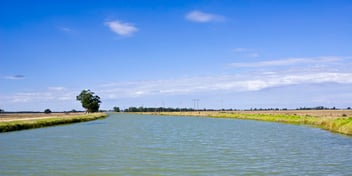New report shows Australia’s cotton industry has cut water use
Producing a bale of cotton in Australia now takes 48% less water, 34% less land and 97% less insecticides than in 1992, according to a recent report outlining the sustainability achievements of one of the country’s largest irrigation sectors.
The cotton industry’s second Australian Cotton Sustainability Report compares performance from 2014 to 2019 across eight categories – water, carbon, biodiversity, pesticides, efficiency, profitability, quality of work life and wellbeing and social capital – highlighting areas of the industry that need improvement.
According to the report, Australian cotton growers now produce almost twice as much cotton from a ML of water than they did in 1992. This is attributed to sustained efforts to improve water use efficiency and crop productivity.
While there is often debate about the amount of water cotton irrigators use, and whether this could be better used elsewhere, Professor Jamie Pittock from the Australian National University’s Fenner School of Environment and Society said cotton could be one of the best crops to cope with a rapidly changing climate.
“This is because cotton is an annual crop: growers plant and harvest in the same 12-month period,” he wrote in the report.
“This means they can look to the year ahead and decide how much to plant given water availability and seasonal rainfall predictions. With the Murray and Darling rivers being some of the most variable river systems in the world, this flexibility to plant more or less in a given year is very valuable.”
However, Pittock also wrote that community, industry and environmental groups within the Murray-Darling Basin should collaborate to ensure water is better distributed, in order to avoid events such as algal blooms and fish kills.
Cotton Australia CEO Adam Kay said the industry aimed to become a global leader in sustainable cotton production.
“Australian cotton growers have been quietly improving their sustainability for decades and should take a moment to celebrate the industry’s collective achievements that are shown in the report,” Kay said.
“Having said that, the report also highlights areas the industry can do better in, such as the need to make greater efforts to reduce carbon emissions, improve nitrogen use efficiency, increase on-farm carbon sequestration in soil and native vegetation and improve farm safety.”
Kay said aiming for a sustainable sector was also crucial to keeping the industry in Australia alive.
“We know if we get sustainability right it can reduce risk, improve efficiency and grow or maintain markets – and ultimately underpin our work to hand the next generation thriving farms and a successful industry,” he said.
Cotton Research and Development Corporation R&D Investment General Manager Allan Williams said the industry will use the report to set five-year targets for 2024 and 2029.
“To be a global leader in sustainable cotton production, we need to set bold targets, ensure our research and adoption program can get us to those targets and frequently and transparently share progress with stakeholders,” he said.
“We will be consulting with growers and other stakeholders inside and outside the industry on setting the right level of ambition in our sustainability targets.
“The industry can point to long-term trends of significant improvement in areas it has focused on in the past, and we will draw on this experience to transform our performance in other areas in the future.”
The 2019 Australian Cotton Sustainability Report is part of the industry’s new PLANET. PEOPLE. PADDOCK. sustainability framework.


